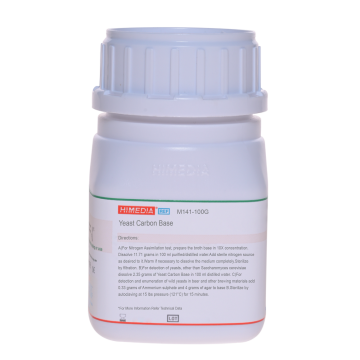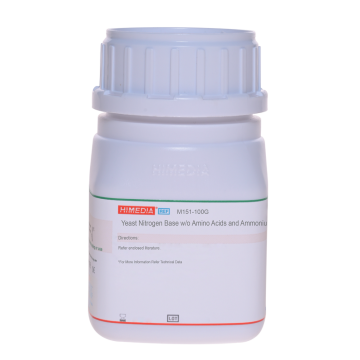 Your enquiry has been submitted
Your enquiry has been submitted
Yeast Nitrogen Base
Molecular Biology#CC293D
Intended Use:
Recommended for classification of yeasts on the basis of their ability to assimilate carbon compounds.
Composition**
| Ingredients | Gms / Litre |
|---|---|
| Ammonium sulphate | 5.000 |
| L-Histidine hydrochloride | 0.010 |
| DL-Methionine | 0.020 |
| DL-Tryptophan | 0.020 |
| Biotin | 0.000002 |
| Calcium pantothenate | 0.0004 |
| Folic acid | 0.000002 |
| Inositol | 0.002 |
| Niacin | 0.0004 |
| p-Amino benzoic acid (PABA) | 0.0002 |
| Pyridoxine hydrochloride | 0.0004 |
| Riboflavin (Vitamin B2) | 0.0002 |
| Thiamine hydrochloride | 0.0004 |
| Boric acid | 0.0005 |
| Copper sulphate | 0.00004 |
| Potassium iodide | 0.0001 |
| Ferric chloride | 0.0002 |
| Manganese sulphate | 0.0004 |
| Sodium molybdate | 0.0002 |
| Zinc sulphate | 0.0004 |
| Potassium dihydrogen phosphate | 1.000 |
| Magnesium sulphate | 0.500 |
| Sodium chloride | 0.100 |
| Calcium chloride anhydrous | 0.100 |
Final pH (at 25°C): 5.4±0.2
**Formula adjusted, standardized to suit performance parameters
Directions
For best results, the medium should be prepared in 10X strength. Suspend 6.75 grams in 100 ml purified / distilled water.
Add 5 grams of dextrose or an equivalent amount of other carbohydrate. Warm if necessary to dissolve the medium completely. Sterilize by filtration. Keep refrigerated until use. Final medium is made by pipetting 0.5 ml into 4.5 ml of sterile purified / distilled water.
Principle And Interpretation
Yeast Nitrogen Base is formulated as per Wickerham (5) for investigations of yeasts for their different abilities in carbon assimilation. With added carbon source it may also be used for susceptibility testing with antifungal drugs when defined liquid medium is needed (3, 4). Inoculate media tubes with very light inoculum and incubate at 25°C for 6-7 days and again for 20-24 days. Draw lines with India ink on a paper and hold the paper against the Yeast Nitrogen Base tubes. If lines are not seen or appear diffused through the culture, the test is considered positive and if lines are distinguishable, test is negative.
Type of specimen
Pure isolates
Specimen Collection and Handling:
For pure isolates samples follow appropriate techniques for handling specimens as per established guidelines (1,2).
After use, contaminated materials must be sterilized by autoclaving before discarding.
Warning and Precautions :
Read the label before opening the container. Wear protective gloves/protective clothing/eye protection/ face protection. Follow good microbiological lab practices while handling specimens and culture. Standard precautions as per established guidelines should be followed while handling specimens. Safety guidelines may be referred in individual safety data sheets.
Limitations :
- Use light inoculum for inoculations.
Performance and Evaluation
Performance of the medium is expected when used as per the direction on the label within the expiry period when stored at recommended temperature.
Quality Control
Appearance Cream to yellow homogeneous free flowing powder
Colour and Clarity of prepared medium Colourless (at 10X concentration colour of medium is pale yellow) clear solution without any precipitate.
Reaction Reaction of 0.67% w/v aqueous solution at 25°C. pH: 5.4±0.2
pH 5.20-5.60
Cultural Response
Cultural characteristics observed after an incubation at 25-30°C for 6-7 days (longer if necessary for unto 24 days).
| Organism | Growth (Plain) | Growth w/ dextrose |
|---|---|---|
| Kloeckera apiculata ATCC 9774 | none-poor | good |
| Saccharomyces cerevisiae ATCC 9763 (00058*) | none-poor | good |
| Saccharomyces uvarum ATCC 28098 | none-poor | good |
Key: *Corresponding WDCM numbers.
Storage and Shelf Life
Store dehydrated and the prepared medium at 2-8°C. Use before expiry date on the label. On opening, product should be properly stored dry, after tightly capping the bottle in order to prevent lump formation due to the hygroscopic nature of the product. Improper storage of the product may lead to lump formation.
Store in dry ventilated area protected from extremes of temperature and sources of ignition. Seal the container tightly after use. Use before expiry date on the label.
Product performance is best if used within stated expiry period.
Disposal
User must ensure safe disposal by autoclaving and/or incineration of used or unusable preparations of this product. Follow established laboratory procedures in disposing of infectious materials and material that comes into contact with sample must be decontaminated and disposed of in accordance with current laboratory techniques (1,2).
Reference
- Isenberg, H.D. Clinical Microbiology Procedures Handbook 2nd Edition.
- Jorgensen, J.H., Pfaller, M.A., Carroll, K.C., Funke, G., Landry, M.L., Richter, S.S and Warnock., D.W. (2015) Manual Clinical Microbiology, 11th Edition. Vol. 1.
- Lennette E. H., Balows, Hausler and Truant, (Eds.), 1980, Manual of Clinical Microbiology, 3rd Ed., ASM, Washington D.C.
- Padhye A. A., 1981, Diagnostic Procedures for Bacterial, Mycotic and Parasitic Infections, 6th Ed., APHA, Washington, D.C.
- Wickerham, 1951, U.S. Dept. Agri. Tech. Bull No. 1029.
| Product Name | Yeast Nitrogen Base |
|---|---|
| SKU | M139 |
| Product Type | Regular |
| Physical Form | Powder |
| Origin | Chemically defined (HiCynth™) |
| Packaging type | HDPE |
| References | 1. Wickerham, 1951, U.S. Dept. Agri. Tech. Bull No. 1029. 2.Lennette E. H., Balows, Hausler and Truant, (Eds.), 1980, Manual of Clinical Microbiology, 3rd Ed., ASM, Washington D.C. 3.Padhye A. A., 1981, Diagnostic Procedures for Bacterial, Mycotic and Parasitic Infections, 6th Ed., APHA, Washington, D.C. |
| Customized Product Available | No |







